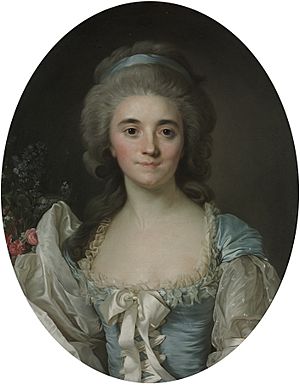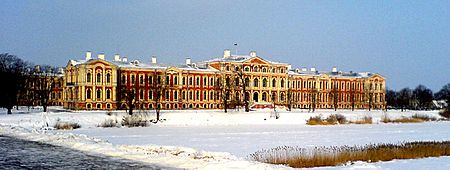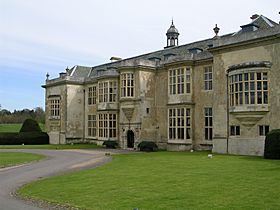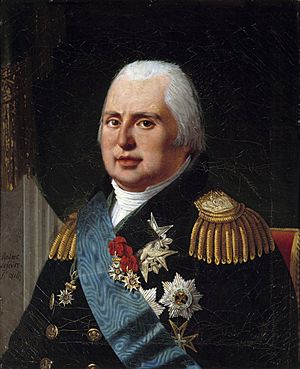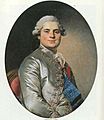Louis XVIII facts for kids
Quick facts for kids Louis XVIII |
|||||
|---|---|---|---|---|---|

Portrait by François Gérard, c. 1814
|
|||||
| King of France (more...) | |||||
| Reign |
|
||||
| Predecessor | Napoleon I (as Emperor of the French) |
||||
| Successor | Charles X | ||||
| Prime Ministers |
See list
|
||||
| King of France (claimant) | |||||
| Tenure |
|
||||
| Predecessor | Louis XVII | ||||
| Born | 17 November 1755 Palace of Versailles, Kingdom of France |
||||
| Died | 16 September 1824 (aged 68) Tuileries Palace, Paris, Kingdom of France |
||||
| Burial | 24 September 1824 Basilica of Saint Denis |
||||
| Spouse | |||||
|
|||||
| House | Bourbon | ||||
| Father | Louis, Dauphin of France | ||||
| Mother | Maria Josepha of Saxony | ||||
| Religion | Catholicism | ||||
| Signature |  |
||||
Louis XVIII (born 17 November 1755 – died 16 September 1824) was the King of France. He ruled from April 1814 to March 1815, and then again from July 1815 to September 1824.
He became king when the French monarchy was brought back after Napoleon I was overthrown. Louis XVIII ruled a constitutional monarchy. This meant he shared power and was not the only leader of the government. However, he still had some say in politics.
Louis XVIII was born in Versailles. He was the brother of Louis XVI of France. In his younger years, he was known as the Comte de Provence. He stayed in Paris when the French Revolution started in 1789. But he escaped to Belgium two years later. After Louis XVI was executed in 1793, and his son Louis XVII died in 1795, he called himself Louis XVIII. He lived in exile in different European countries. He became king after Napoleon gave up power in 1814. However, when Napoleon returned in 1815, Louis fled to Belgium again. Later that year, he was put back on the throne after Napoleon's final defeat at Waterloo. He remained king until he died in 1824.
Louis XVIII: King of France
Early Life and Family
Louis Stanislas Xavier was born on 17 November 1755 at the Palace of Versailles. From birth, he was called the Count of Provence. He was a younger son of Louis, Dauphin of France, and his wife Maria Josepha of Saxony. His grandfather was the reigning King Louis XV.
Louis Stanislas was christened six months after his birth. This was a tradition in the Bourbon family. He was named Louis because it was common for French princes. Stanislas honored his great-grandfather, King Stanislaus I of Poland. Xavier was chosen for Saint Francis Xavier, a patron saint of his mother's family.
At his birth, Louis Stanislas was fourth in line to the French throne. This was behind his father and two older brothers. His brother, Louis Joseph Xavier, Duke of Burgundy, died in 1761. His father, the Dauphin, died in 1765. These deaths made Louis Stanislas second in line to the throne. His brother Louis Auguste became the Dauphin.
Louis Stanislas was a smart boy and did well in his studies. His education was very religious. Many of his teachers were priests. His teachers taught him how princes should "know how to withdraw themselves, to like to work," and "to know how to reason correctly."
In April 1771, at age 15, Louis Stanislas finished his formal education. He then set up his own household. It was very grand, with 390 servants by 1773. His grandfather, Louis XV, gave him several titles. These included Duke of Anjou and Count of Maine. During this time, he was often known as the Count of Provence.
Marriage and Royal Court
On 16 April 1771, Louis Stanislas married Princess Maria Giuseppina of Savoy by proxy. The actual ceremony took place on 14 May at the Palace of Versailles. Marie Joséphine was the daughter of Victor Amadeus, Duke of Savoy.
A big ball followed the wedding on 20 May. Louis Stanislas did not find his wife appealing. She was thought to be plain and not used to the ways of the Versailles court. At the time of his marriage, Louis Stanislas was overweight.
On 10 May 1774, King Louis XV died. Louis Stanislas's older brother, Louis Auguste, became King Louis XVI. As the King's eldest brother, Louis Stanislas received the title Monsieur. He wanted to have political power. He tried to join the King's council in 1774 but failed. Louis XVI gave Louis Stanislas income from the Duchy of Alençon in December 1774. This was to increase his importance.
Louis Stanislas traveled more around France than other royals. In 1774, he went with his sister Clotilde to Chambéry. In 1775, he visited Lyon.
On 19 December 1778, Queen Marie Antoinette gave birth to a daughter. She was named Marie-Thérèse Charlotte de France. This was good news for the Count of Provence. He kept his place as heir to Louis XVI. This was because Salic law meant women could not become Queen of France. However, Louis Stanislas did not remain heir for long. On 22 October 1781, Marie Antoinette gave birth to a son, Louis Joseph. When she had her second son, Louis Charles, in March 1785, Louis Stanislas moved further down the line of succession.
Louis Stanislas lived a quiet life. He spent time in his large library of over 11,000 books. In the early 1780s, he built up huge debts. His brother Louis XVI paid these debts for him.
In February 1787, an Assembly of Notables met. These were important people like judges, mayors, nobles, and clergy. They met to approve new financial plans. The Count of Provence did not like these plans. He saw this as a chance to get involved in politics. The plans were rejected, and the King dismissed his finance minister. The new minister also failed to get the plans approved.
The King then tried to force the plans through the Parlement of Paris. This group was responsible for approving the King's laws. The Parlement refused. They said any new taxes needed approval from an Estates-General. This was France's parliament. The King arrested two members of the Parlement. This led to riots in several areas. The clergy also spoke out against the tax plans. Finally, the King agreed to call the Estates-General in 1789.
In November 1788, a second Assembly of Notables met. They discussed how the Estates-General should be set up. The Parlement de Paris suggested it should be like the last assembly in 1614. This would give more power to the clergy and nobles. Louis Stanislas was the only notable to vote to increase the size of the Third Estate. The King agreed to give the Third Estate more representation.
French Revolution and Flight
The Estates-General met in May 1789 to approve financial changes. The Count of Provence wanted a strong stand against the Third Estate. On 17 June, the Third Estate declared itself a National Assembly. This was an assembly of the people, not just the estates.
The Count of Provence urged the King to act strongly. But the King was unsure. On 9 July, the assembly called itself a National Constituent Assembly. It planned to create a Constitution for France. On 11 July, Louis XVI dismissed his minister, which caused riots in Paris. On 12 July, a cavalry charge against a crowd led to the Storming of the Bastille two days later.
On 16 July, the King's brother, Charles, Comte d'Artois, left France with his family. Many other nobles also left. The Count of Provence chose to stay at Versailles. When the Royal Family planned to escape to Metz, Provence advised the King not to leave. The King agreed.
The Royal Family was forced to leave Versailles on 6 October 1789. They were taken to Paris. The Count of Provence and his wife stayed in the Luxembourg Palace. The rest of the Royal Family stayed in the Tuileries Palace. In March 1791, a law was made about who would rule if the King died and his son was too young. This law named the Count of Provence as regent.
The Count of Provence and his wife fled to the Austrian Netherlands in June 1791. This happened at the same time as the royal family's failed Flight to Varennes.
Years in Exile
When the Count of Provence arrived in the Low Countries, he declared himself the acting ruler of France. He used a document he and Louis XVI had written. This document gave him the power to rule if his brother died or could not perform his duties. He soon joined other exiled princes in Coblenz. There, he and his brothers said they wanted to invade France. Louis XVI was annoyed by their actions. Provence sent people to other European countries to ask for money, soldiers, and weapons.
In August 1791, the rulers of Prussia and the Holy Roman Empire issued the Declaration of Pillnitz. This urged Europe to act if Louis XVI or his family were threatened. Provence's support for this declaration was not popular in France.
In January 1792, the Legislative Assembly declared that all exiles were traitors. Their property and titles were taken away. On 21 September 1792, the French monarchy was abolished.
Louis XVI was executed in January 1793. His young son, Louis Charles, became the King in name. The exiled princes called Louis Charles "Louis XVII of France". The Count of Provence then declared himself regent for his nephew.
The young King died in prison in June 1795. His only living sibling was his sister Marie-Thérèse. She could not be queen because of France's Salic law. So, on 16 June, the exiled princes declared the Count of Provence "King Louis XVIII". The new king accepted this and wrote a statement called the "Declaration of Verona". In it, he asked France to return to the monarchy.
Louis XVIII helped free Marie-Thérèse from her Paris prison in 1795. He wanted her to marry her cousin, Louis Antoine, Duke of Angoulême. Louis XVIII told her that her parents wanted this marriage. She agreed to his wishes.
Louis XVIII had to leave Verona when Napoleon Bonaparte invaded the Republic of Venice in 1796.
Life in Jelgava and Warsaw
In 1798, Tsar Paul I of Russia offered Louis the use of Jelgava Palace in Courland (now Latvia). The Tsar also gave Louis money. Marie-Thérèse finally joined Louis XVIII at Jelgava in 1799. Louis XVIII tried to bring back the court life of Versailles there.
On 9 June 1799, Marie-Thérèse married her cousin Louis-Antoine at Jelgava Palace. Louis XVIII wanted to show a united family. He ordered his wife, Queen Marie Joséphine, to attend the wedding. This marriage was not happy and they had no children.
In 1800, Louis XVIII tried to talk to Napoleon Bonaparte. He asked Napoleon to bring the Bourbons back to the throne. But Napoleon was not interested. He was focused on becoming the ruler of France himself.
In January 1801, Tsar Paul told Louis XVIII that he could no longer live in Russia. The court had to sell some things to pay for their journey out of Russia. Marie-Thérèse even sold a diamond necklace.
Marie-Thérèse convinced Queen Louise of Prussia to give her family a safe place in Prussia. Louis XVIII used the name Comte d'Isle. From 1801 to 1804, he and his family lived at the Łazienki Palace in Warsaw.
In 1803, Napoleon tried to make Louis XVIII give up his claim to the French throne. But Louis refused. In May 1804, Napoleon declared himself Emperor of the French. Louis XVIII and his nephew spoke out against Napoleon's move. When the King of Prussia told Louis XVIII to leave, Tsar Alexander I invited him back to Jelgava. Louis XVIII decided to go to England as soon as possible.
Louis XVIII realized that France would not accept a return to the old ways. So, in 1805, he changed his public plans. He promised to end conscription (forced military service). He also said he would keep Napoleon's government and justice system. He promised to lower taxes and give amnesty to those who did not oppose the monarchy.
Louis XVIII had to leave Jelgava again in July 1807. He sailed to Stockholm and then to Great Yarmouth in England. He settled at Gosfield Hall in Essex.
Life in England
In 1808, Louis's wife, Marie Joséphine, joined him in England. He soon moved to Hartwell House in Buckinghamshire. Over one hundred of his courtiers lived there. The Prince of Wales (who later became King George IV) was very kind to the exiled Bourbons. He gave them a safe place to live and generous allowances.
Queen Marie Joséphine died on 13 November 1810. That winter, Louis had a bad attack of gout. This was a common problem for him. He had to use a wheelchair.
In 1812, Napoleon I invaded Russia. This war was a turning point for Napoleon. His army was badly defeated.
In 1813, Louis XVIII made another statement from Hartwell. This was even more liberal than his earlier ones. He said that those who had served Napoleon would not be punished. He also promised that the original owners of lands taken during the Revolution would be paid back.
Allied troops entered Paris on 31 March 1814. Louis, who could not walk well, had sent his brother, the Count of Artois, to France. Napoleon I gave up his power on 11 April.
Return to Power: The First Restoration
The Count of Artois ruled as acting leader until Louis XVIII arrived in Paris on 3 May. When he returned, the King showed himself to his people in a procession. He moved into the Tuileries Palace that same day. His niece, the Duchess of Angoulême, was very emotional seeing the Tuileries. She had been imprisoned there during the French Revolution.
Napoleon's senate invited Louis XVIII to be king. They wanted him to accept a constitution. This constitution would recognize the Republic and the Empire. It also wanted a parliament elected every year and the French flag with three colors. Louis XVIII did not like the senate's constitution. He said he was "disbanding the current senate" and appealing to the French people.
The powerful countries occupying Paris demanded that Louis XVIII create a constitution. Louis responded with the Charter of 1814. This charter included many modern ideas. It gave freedom of religion. It created a legislature with two parts: the Chamber of Deputies and the Chamber of Peers. The press would have some freedom. It also promised to pay back former owners of lands taken during the Revolution. Catholicism became the official religion of France.
Louis XVIII signed the Treaty of Paris on 30 May 1814. This treaty gave France its 1792 borders. France did not have to pay for the war. The armies occupying France left immediately. These good terms would change after Napoleon's return in 1815.
Louis XVIII soon broke one of his promises. He and his finance minister wanted to avoid debt. They kept the unpopular taxes on tobacco, wine, and salt. Louis had promised to abolish these taxes. This led to riots in Bordeaux. Money spent on the army was cut in the 1815 budget.
Louis XVIII was very interested in the Congress of Vienna. This meeting was set up to redraw the map of Europe after Napoleon's fall. France was represented by Prince Talleyrand. Louis was worried about Prussia taking over Saxony. He also wanted the Duchy of Parma to go back to the Bourbon family.
In February 1815, Austria agreed to send troops to the Kingdom of Naples. They wanted to remove the ruler there, Joachim Murat. Louis had created fake letters to show Murat was working with Napoleon. Louis also paid for the Austrian army's trip. Louis XVIII succeeded in getting the Bourbons back in Naples.
The Hundred Days and Second Restoration
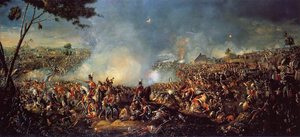
On 26 February 1815, Napoleon Bonaparte escaped from his island prison of Elba. He landed in France with about 1,000 soldiers on 1 March. Louis XVIII was not very worried at first. He thought such a small army could be easily defeated. However, Louis XVIII had not removed Napoleon's supporters from the army. This led to many soldiers leaving the Bourbon armies to join Bonaparte. Louis XVIII also could not lead the fight against Napoleon because of his gout.
Louis XVIII's underestimation of Bonaparte was a disaster. On 19 March, the army outside Paris joined Bonaparte. This left the city open to attack. That same day, Louis XVIII left Paris with a small group. He went to Lille and then crossed into the United Kingdom of the Netherlands, stopping in Ghent. Other leaders wondered if the Duke of Orleans should be king instead of Louis XVIII.
However, Napoleon did not rule France for long. He suffered a major defeat at the Battle of Waterloo on 18 June. This was at the hands of the armies led by the Duke of Wellington and Field Marshal Blücher. The Allies agreed that Louis XVIII should be put back on the throne of France.
Louis returned to France quickly after Napoleon's defeat. He wanted to make sure he was restored as king. He arrived at Cambrai on 26 June. There, he made a statement. He said that those who served Napoleon during the Hundred Days would not be punished, except for the main leaders. He also admitted that his government might have made mistakes before. He promised a constitution that would protect public debt, freedom of the press and religion, and equality before the law. He kept these promises.
On 8 July, the King entered Paris to a big welcome. The Tuileries Palace gardens were full of people. The crowds cheered so loudly that the Duke of Wellington said he could not talk to the King.
Some returning exiles wanted revenge and to bring back the old ways. But the new king refused this advice. He called for peace and unity. The exiles did not get their lands back, but they were later paid for their losses. The Catholic Church was favored. Only the richest men in France could vote. Most of them had supported Napoleon. In foreign policy, he removed Talleyrand. He continued most of Napoleon's policies peacefully.
The King gave most of his duties to his council. In the summer of 1815, he and his ministers started reforms. The Royal Council was replaced by a smaller, more formal privy council. Talleyrand was appointed as the first Prime Minister of France. On 14 July, the army units seen as "rebellious" were disbanded. Hereditary peerage (titles passed down in families) was brought back.
In August, elections for the Chamber of Deputies did not go well for Talleyrand. The voters chose mostly ultra-royalists. The Duchess of Angoulême and the Count of Artois pushed King Louis to dismiss his ministers. Talleyrand resigned on 20 September. Louis chose the Duke of Richelieu as his new Prime Minister. Louis dissolved the Chambre introuvable on September 5, 1816.
There was strong anti-Napoleon feeling in Southern France. This led to the Second White Terror. Many important officials who had worked for Napoleon were removed from government. Some were executed or killed. Louis publicly said he was against these illegal acts. But he supported punishing army marshals who had helped Napoleon. Louis's government executed Napoleon's Marshal Ney in December 1815 for treason.
The King did not want to shed much blood. This angered the ultra-royalist Chamber of Deputies. They felt Louis was not punishing enough people. In January 1816, the government offered amnesty to "traitors." But trials that had already started continued. This declaration also banned any member of the House of Bonaparte from owning property or entering France. It is thought that between 50,000 and 80,000 officials were removed from government during this time.
In November 1815, Louis's government had to sign another Treaty of Paris. This treaty formally ended Napoleon's Hundred Days. This new treaty was much harder on France. France's borders were smaller, back to their 1790 size. France also had to pay for an army to occupy it for at least five years. This cost 150 million francs per year. France also had to pay 700 million francs to the Allies for war damages.
In 1818, new laws increased the size of the army by over 100,000 soldiers. In October of that year, Louis's foreign minister, the Duke of Richelieu, convinced the Allied Powers to withdraw their armies early. This was in exchange for over 200 million francs.
Louis chose many moderate cabinets. He wanted to keep the people happy. This often upset his brother, the ultra-royalist Count of Artois. Louis worried that his brother, who would be his heir, would abandon the moderate government for a strict ultra-royalist rule.
Louis XVIII did not like Louis-Philippe d'Orléans. He often treated him poorly. This was partly because Louis-Philippe's father had voted for Louis XVI's execution. Louis XVIII's nephew, the Duke of Berry, was killed on 14 February 1820. The royal family was very sad. Louis broke an old tradition by attending his nephew's funeral. Previous French kings did not attend funerals. The Duke of Berry's death meant that the Orleans family was more likely to inherit the throne.
Berry's wife gave birth to a son after his death in September. This was Henry, Duke of Bordeaux. The Bourbons called him Dieudonné (God-given). They thought he had secured the future of the family. However, the Bourbon succession was still uncertain. The Chamber of Deputies suggested changing Salic law to allow the Duchess of Angoulême to become queen. In 1823, France sent troops to Spain. There had been a revolt against King Ferdinand VII. France successfully stopped the rebellion. The Duke of Angoulême led this campaign.
Death and Legacy
Louis XVIII's health began to worsen in the spring of 1824. He suffered from obesity, gout, and gangrene in his legs and spine. Louis died on 16 September 1824. He was surrounded by his family and government officials. His youngest brother, the Count of Artois, became King Charles X.
Louis XVIII was the last French monarch to die while still ruling after 1774. He was buried at the Basilica of St Denis. This is the burial place of French kings.
Honours
 Kingdom of France:
Kingdom of France:
- Knight of the Order of the Holy Spirit, 2 February 1767
- Grand Master and Knight of the Order of Saint Michael
- Grand Master and Grand Croix of the Legion of Honour
- Grand Master and Grand Croix of the Order of Saint Louis
- Grand Master and Grand Croix of the Order of Saint Lazarus
 Austrian Empire: Grand Cross of the Order of St. Stephen, 31 August 1815
Austrian Empire: Grand Cross of the Order of St. Stephen, 31 August 1815 Denmark: Knight of the Order of the Elephant, 25 January 1818
Denmark: Knight of the Order of the Elephant, 25 January 1818 Kingdom of Portugal: Grand Cross of the Sash of the Three Orders, 10 October 1823
Kingdom of Portugal: Grand Cross of the Sash of the Three Orders, 10 October 1823 Kingdom of Prussia:
Kingdom of Prussia:
- Knight of the Order of the Black Eagle, 17 July 1815
- Grand Cross of the Order of the Red Eagle, 31 August 1815
 Russian Empire:
Russian Empire:
- Knight of the Order of St. Andrew, 5 March 1800
- Knight of the Order of St. Alexander Nevsky, 5 March 1800
 Spain: Knight of the Order of the Golden Fleece, 22 May 1767
Spain: Knight of the Order of the Golden Fleece, 22 May 1767 United Kingdom: Stranger Knight of the Order of the Garter, 21 April 1814
United Kingdom: Stranger Knight of the Order of the Garter, 21 April 1814
Succession
The French line of succession after Louis XVIII died in 1824.
 Louis XV (1710–1774)
Louis XV (1710–1774)
- Louis, Dauphin of France (1729–1765)
- Louis, Duke of Burgundy (1751–1761)
 Louis XVI (1754–1793)
Louis XVI (1754–1793)
- Louis Joseph, Dauphin of France (1781–1789)
 Louis XVII (1785–1795)
Louis XVII (1785–1795)
 Louis XVIII (1755–1824)
Louis XVIII (1755–1824)- (1) Charles, Count of Artois (b. 1757)
- (2) Louis Antoine, Duke of Angoulême (b. 1775)
- Charles Ferdinand, Duke of Berry (1778–1820)
- Louis, Dauphin of France (1729–1765)
- (3) Henri, Duke of Bordeaux (b. 1820)
Images for kids
-
The Count of Provence and his brother Louis Auguste, Duke of Berry (later Louis XVI), depicted in 1757 by François-Hubert Drouais
-
Louis Stanislas, Count of Provence, during the reign of Louis XVI of France
-
Marie Joséphine, Countess of Provence, Louis Stanislas' wife, by Jean-Baptiste André Gautier-Dagoty, 1775
-
Old Bumblehead the 18th trying on the Napoleon Boots – or, Preparing for the Spanish Campaign, by George Cruikshank, mocking the French intervention in Spain
-
The royal family. From left to right: Charles, Count of Artois, Louis XVIII, Marie Caroline, Duchesse of Berry, Marie Thérèse, Duchesse of Angoulême, Louis Antoine, Duke of Angoulême and Charles Ferdinand, Duke of Berry
See also
 In Spanish: Luis XVIII de Francia para niños
In Spanish: Luis XVIII de Francia para niños
- List of works by James Pradier


